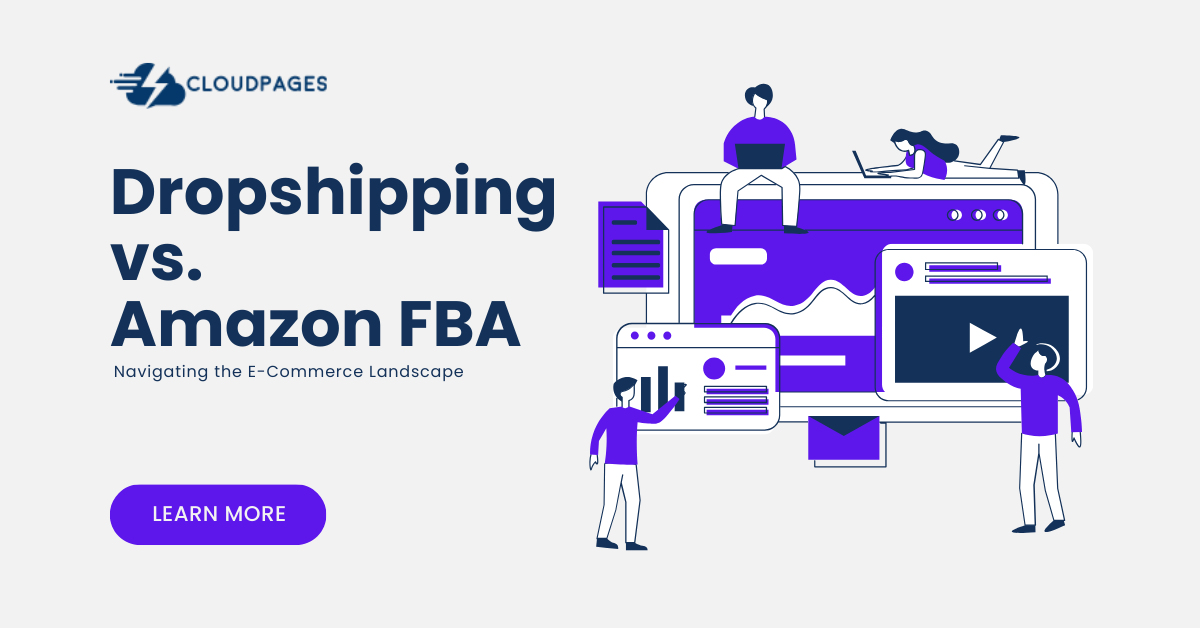Dropshipping vs. Amazon FBA
In the ever-evolving world of e-commerce, entrepreneurs have various business models at their disposal. Two popular choices are dropshipping and Amazon FBA (Fulfillment by Amazon). Both models offer unique advantages and challenges, catering to different entrepreneurial aspirations. In this article, we’ll explore the intricacies of dropshipping and Amazon FBA, highlighting the key differences and providing insights to help aspiring business owners make informed decisions.

Table of Contents
Dropshipping
Dropshipping is a distinctive retail fulfillment strategy characterized by a deviation from traditional inventory management practices. In this innovative approach, a store refrains from maintaining an inventory of the products it offers for sale. Instead, when a customer places an order, the store procures the desired product from a third-party supplier. The intriguing aspect lies in the fact that the store does not physically stock or handle the product; instead, it orchestrates the purchase and subsequently arranges for the direct shipment of the item from the supplier to the end customer. This streamlined process eliminates the need for the retailer to invest in and manage inventory, providing a more dynamic and resource-efficient model for online businesses.
Pros of Dropshipping
- Low Initial Investment – Dropshipping requires minimal upfront investment as there’s no need to purchase and store inventory.
- Flexibility – Business owners can operate from anywhere, as they don’t handle physical products. This flexibility is attractive for those who prefer remote or location-independent work.
- Wide Product Range – Dropshippers can offer a broad array of products without the constraints of managing physical inventory.
Cons of Dropshipping
- Thin Profit Margins – The convenience of dropshipping comes at a cost, with lower profit margins compared to models that involve holding inventory.
- Dependency on Suppliers – Reliance on third-party suppliers means less control over inventory levels, product quality, and shipping times.
- Intense Competition – The low barriers to entry result in a saturated market, making it challenging to stand out without a unique value proposition.
Amazon FBA
Amazon FBA, or Fulfillment by Amazon, represents an innovative program that revolutionizes the logistics and operational aspects of e-commerce. Within this framework, third-party sellers entrust their products to the expansive infrastructure of Amazon. The process begins with sellers shipping their merchandise to Amazon’s state-of-the-art fulfillment centers. Once the products arrive, Amazon takes on the responsibility of meticulously storing, packaging, and dispatching these items to end customers when orders are placed.
This comprehensive service extends beyond mere storage, as Amazon employs advanced algorithms and technology to optimize the fulfillment process. The company ensures that inventory is efficiently managed, minimizing the chances of stockouts or delays. The seamless integration of storage, packing, and shipping services provided by Amazon FBA allows sellers to focus on the core aspects of their businesses, such as marketing, product development, and customer engagement.
Pros of Amazon FBA
- Prime Eligibility – Products fulfilled by Amazon are often eligible for Prime shipping, providing a competitive edge in terms of fast and reliable delivery.
- Scalability – With Amazon handling logistics, sellers can focus on scaling their business and expanding their product offerings.
- Customer Trust – Amazon’s reputation for customer service and satisfaction can positively impact a seller’s brand image.
Cons of Amazon FBA
- Fees and Costs – Amazon FBA involves various fees, including storage fees, fulfillment fees, and referral fees, which can impact overall profitability.
- Limited Control – Sellers relinquish control over certain aspects of their business, such as packaging and shipping processes.
- Intense Competition – The vast number of sellers on the Amazon platform can make it challenging to differentiate and stand out in the marketplace.
Differences Between Dropshipping and Amazon FBA
| Aspect | Dropshipping | Amazon FBA |
|---|---|---|
| Inventory Management | No need to hold inventory; relies on suppliers. | Sellers send inventory to Amazon’s fulfillment centers. |
| Initial Investment | Low; minimal upfront costs. | Moderate; includes inventory and potential fees. |
| Flexibility | High; operates from anywhere. | Moderate; tied to Amazon’s fulfillment infrastructure. |
| Profit Margins | Lower due to thin margins. | Can vary; affected by fees but potentially higher. |
| Control Over Products | Limited; dependent on suppliers. | Limited; Amazon handles aspects of fulfillment. |
| Brand Independence | More control over branding. | Less control; products listed on Amazon’s marketplace. |
| Shipping Times | Can vary depending on suppliers. | Fast and reliable with Prime shipping eligibility. |
| Competition | Intense due to low entry barriers. | Fierce competition on the Amazon marketplace. |
Further Aspects to Consider
1. Customer Service and Returns
- Dropshipping: Handling customer service and returns can be challenging as the drop shipper is often a middleman between the customer and the supplier. This can result in longer response times and potential complications in the return process.
- Amazon FBA: Amazon takes charge of customer service and returns, streamlining the process and providing a more standardized and efficient experience for buyers. However, sellers may have less control over customer interactions.
2. Brand Building
- Dropshipping: Allows for greater control over brand identity and marketing strategies. Building a distinct brand becomes essential to stand out in a crowded market.
- Amazon FBA: While brand building is possible, sellers operate within the Amazon ecosystem, making it challenging to establish a fully independent brand presence. Success often relies on product quality and positive customer reviews.
3. Marketplace Dependency
- Dropshipping: Businesses can operate through various online platforms or their standalone websites, reducing dependency on a single marketplace.
- Amazon FBA: Sellers are reliant on Amazon’s marketplace, and changes in Amazon’s policies or algorithms can impact visibility and sales. Diversifying sales channels becomes important.
4. Ease of Entry
- Dropshipping: Low barriers to entry make it accessible for beginners, but this also results in increased competition and the need for unique value propositions.
- Amazon FBA: While it requires more initial investment, Amazon FBA provides a straightforward entry point into e-commerce, leveraging the trust and reach of the Amazon platform.
5. Data Ownership
- Dropshipping: Sellers have more control over customer data, allowing for targeted marketing efforts and building a direct relationship with customers.
- Amazon FBA: Amazon retains control over customer data, limiting the ability of sellers to directly market to their customers outside of the Amazon platform.
Making an Informed Decision
- Evaluate Your Goals: Consider your long-term goals for the business. If you prioritize building an independent brand, dropshipping might be a more suitable option. If scalability and leveraging a trusted platform are crucial, Amazon FBA could be the right fit.
- Financial Considerations: Assess your budget and risk tolerance. Dropshipping requires less upfront investment, making it a lower-risk option. However, Amazon FBA can offer higher potential returns if managed effectively.
- Market Research: Understand your target market and competition. Analyze trends, consumer behavior, and the competitive landscape to determine which model aligns with market demands.
- Personal Preferences: Consider your working style and preferences. If you prefer more control over logistics and branding, drop shipping may be appealing. If you value the convenience of a streamlined fulfillment process, Amazon FBA could be a better fit.
- Diversification: Explore opportunities for diversification. Combining both models or expanding to other sales channels can reduce risk and enhance the overall resilience of your e-commerce business.
Conclusion – Dropshipping vs. Amazon FBA
Choosing between dropshipping and Amazon FBA depends on various factors, including your business goals, budget, and preference for control. Dropshipping is ideal for those seeking a low-risk entry into e-commerce, while Amazon FBA offers scalability and the advantage of leveraging Amazon’s vast customer base. Ultimately, understanding the nuances of each model is crucial for making an informed decision that aligns with your entrepreneurial vision.



